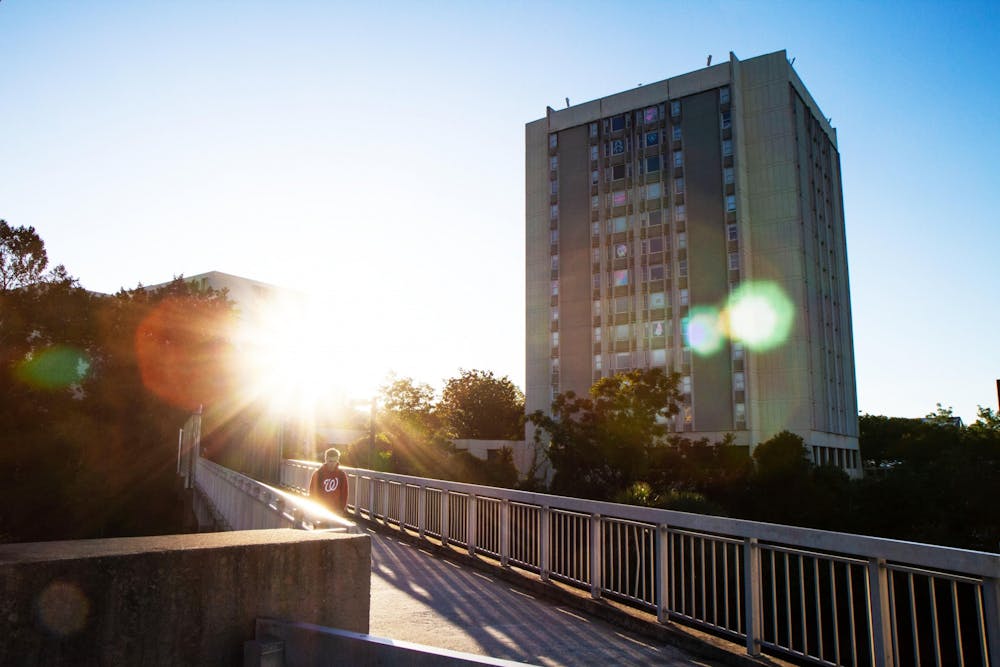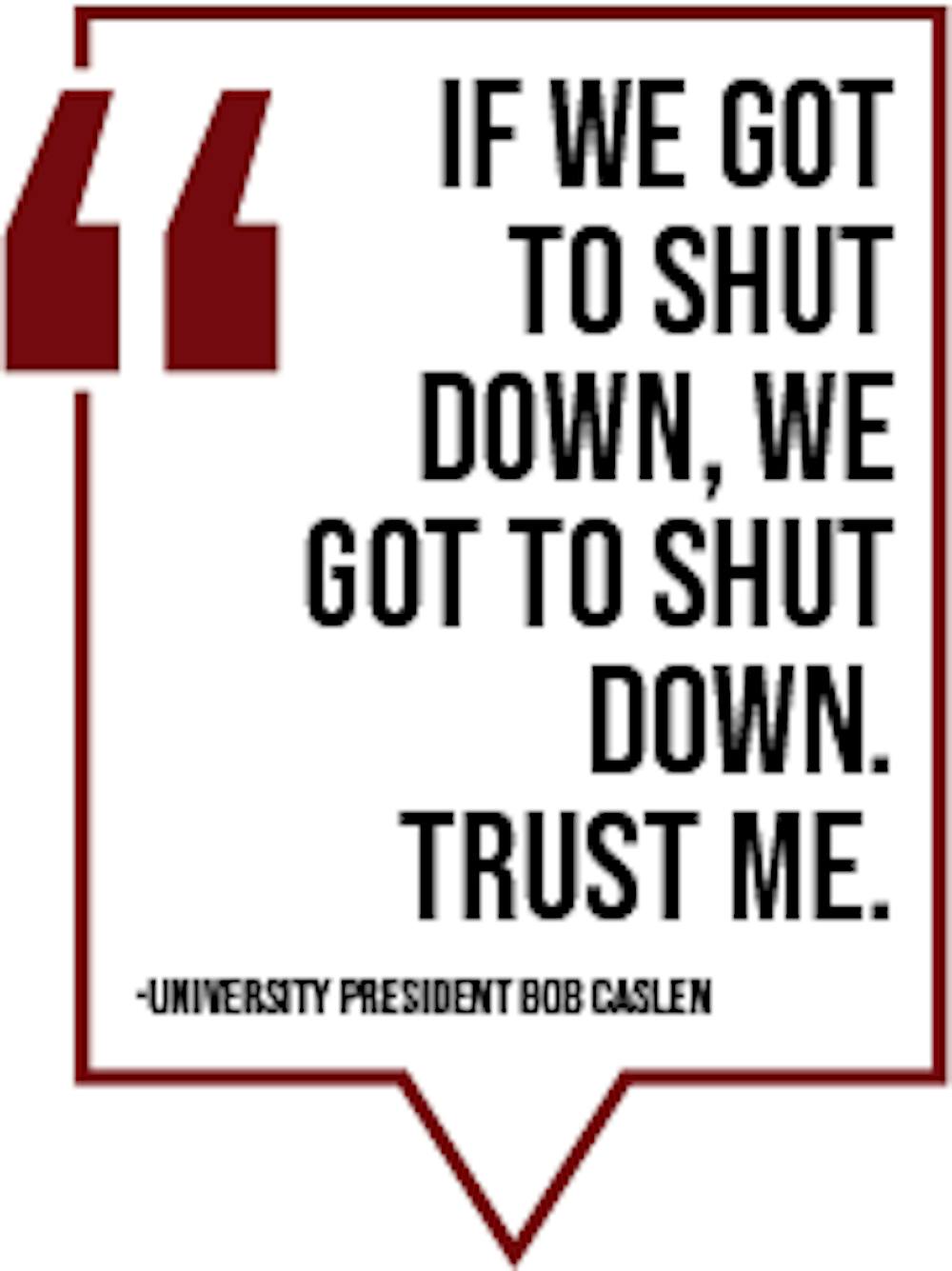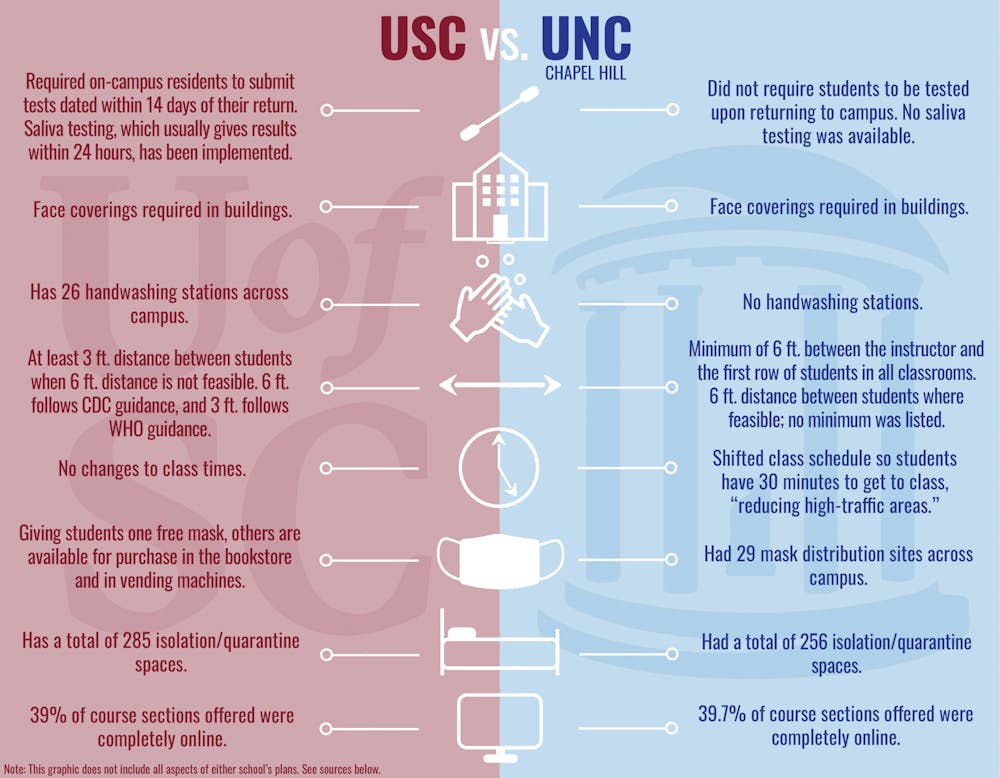The University of South Carolina is returning to a “new normal,” after months with most students away from campus. With several other universities shutting down shortly after reopening, the question lingers: How long will this new normal last?
With bringing students back to campus, there is bound to be an increase in cases when compared to the summer months, President Bob Caslen said. He said he wants students to know “that's just the natural, normal thing that's going to happen.”
“For us to increase in scale by 10 times the population and not to see any increases whatsoever in positives, that's not just realistic,” Caslen said.
The University of North Carolina at Chapel Hill saw 135 new cases within a week of starting classes. The school moved online on Aug. 17. According to an article by Bloomberg, UNC was one of the largest universities to bring students back to campus this fall. UNC’s undergraduate population is about 7,000 less than USC’s.
UNC did not require students to be tested before returning to campus. USC required all on-campus residents to submit tests dated within 14 days of their return.
USC and UNC both allocated isolation housing for students who have tested positive for COVID-19 and quarantine housing for students who have come into contact with someone who has tested positive.
UNC's total capacity for that housing was 256: 171 spaces for quarantining students and 85 for isolating students.
USC's current total capacity is 285.

Bates West is serving as the isolation dorm with 180 spaces. The National Advocacy Center, which is across the street from Gambrell, is the quarantine building with 105 spaces for students. Bates West's isolation spaces can be used for quarantine overflow if needed, Deborah Beck, the executive director of Student Health Services, said.
For the week of Aug. 14 to Aug. 20 – the most recently reported week – these buildings are at 4.9% of their total capacity, which means 14 spaces are in use.
If these buildings were to hit their capacity, Beck said the next steps would be to send some students in the quarantine/isolation spaces home and to work with the community in finding other available locations.
“The other great thing that we're able to do is, we've hired a lot of case managers, and every student who tests positive that is on our campus in isolation, our nurses are reaching out to them every day; they're checking in and helping them to monitor their symptoms,” Beck said.
On Wednesday, USC's College of Pharmacy introduced saliva testing, which usually gives students results within 24 hours – faster than the typical three to five days for a nasal swab test. The saliva testing is walk-up and does not require an appointment.
Caslen said the saliva testing is “a huge game-changer.”
The College of Pharmacy website notes the schedule for saliva testing and says, "You should not participate in SAFE testing if you are experiencing COVID-19 symptoms or have had close contact with someone infected with COVID-19."
It recommends going to the Student Health Center for a nose swab test instead.
Notre Dame University, which was able to test all 12,000 of its students before they returned to campus, has moved instruction online for two weeks. USC required all on-campus residents to get COVID-19 tests before coming to campus, which is about 27% of the university’s population, according to U.S. News & World Report.
“Although we haven't tested every single person that's come back … our health center’s testing anywhere between 250 to 300 a day, and now the College of Pharmacy has also been ramped up and they're doing saliva testing five days a week. So, we are going to be testing a huge portion of our students,” Beck said.
In an email, Beck said from Aug. 1 to Aug. 18 a total of 8,379 students have uploaded COVID-19 tests to MyHealthSpace, including 5,994 on-campus residents.
If it becomes necessary, Caslen said he would shut the university down.

“If we got to shut down, we got to shut down. Trust me. I mean, just like what we did last March, I think we were one of the first universities in the nation to shut down. So, I'm not afraid to shut down,” Caslen said.
However, he said he also recognizes if the campus closes, that shifts the responsibility of students onto the city of Columbia.
“There are huge issues if we shut down. Whether we shut down for two weeks, or we shut down for a month or whatever. And specifically, if we shut down, we're going to transfer all of our problems to the community,” Caslen said.
The university recently released its COVID-19 dashboard, which shows statistics on how many active cases the school is dealing with, the capacity of the quarantine and isolation dorms and other data.
It also includes an alert level, which ranges from “new normal” to “high.” The university currently sits at the “new normal” level, the lowest on the alert scale. Eleven factors go into the alert level, including campus testing, contact tracing and mitigation behaviors.
Beck said none of these factors weigh more heavily than the others. She also said there is no “magic number” of cases that would force the university to close.
“Numbers are really not the best way to quantify whether or not you have a problem with COVID," Beck said. "You've got to look at all these 11 factors.”
Caslen said he is glad to have students back on campus and feels “they know how to do the right thing.”
“If our plan is going to be successful, our students and our faculty, our administration, all of us together have got to make this thing work,” Caslen said.
Infographic sources: USC safety guidelines webpage, USC housing webpage, USC COVID-19 dashboard, UNC classroom spaces webpage, UNC COVID-19 dashboard and Bloomberg

